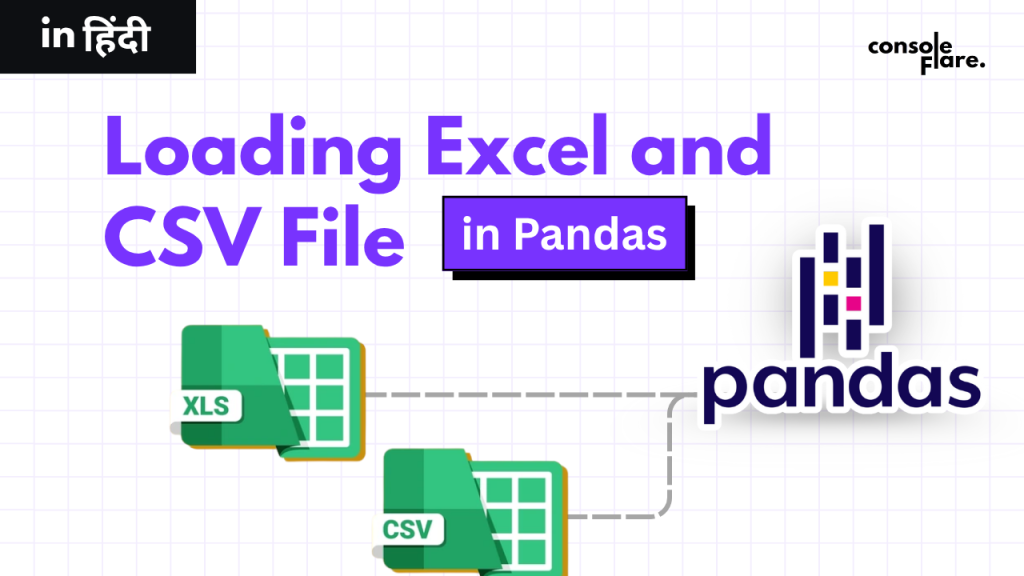What is Pandas?
Pandas is one of the most widely used libraries in Python for working with data. With just a few lines of code, it enables you to load, clean, analyze, and show data. Pandas will be your everyday friend if you’re just getting started with data science.
External Resource: https://pandas.pydata.org/docs/getting_started/index.html
The Benefits of Using Pandas for Data Analysis
You must properly load your dataset before you can analyze or visualize anything.
Pandas allow you to:
- Easily import data from CSV or Excel files
- Clear up messy datasets
- Handle missing values or rename columns.
- Utilize the built-in data functions to save time.
Step 1: Import Pandas Library (Steps to Load Data in Pandas)
Before anything else, you need to import the Pandas library.
We usually import it with an alias for convenience:
import pandas as pdHere, pd is just a short name we use so that every time we call a Pandas function, we don’t have to write pandas in full.
Step 2: Types of Data Files
There are generally two common file types you’ll encounter:
-
Excel files (
.xlsxor.xls) -
CSV files (
.csv)
Pandas has easy functions that work with both formats.
Step 3: Loading Excel Files in Pandas
First thing to understand before you start working with pandas is how to load your data. In this guide, we show how to load Excel and CSV files into pandas.
To load Excel files, we use the read_excel() method.
data = pd.read_excel(r"C:\Users\abhis\Desktop\Adidas US Sales Datasets.xlsx")
dataTip: To prevent issues caused by backslashes (\), always use a raw string (r”…”) for file paths in Windows.
Excel Reader Dependency
Pandas doesn’t read Excel files on its own – it needs an additional engine.
You may install one using:
pip install openpyxl
or
pip install xlrdPandas automatically finds which engine is available, but openpyxl is preferred for modern Excel files.
Common Issue: Missing Excel Reader
If you try to load an Excel file without installing a reader, you’ll get this error:
ImportError: Missing optional dependency 'openpyxl'. Use pip or conda to install openpyxl.Simply install the missing package and rerun your code.
Step 4: Loading Data Without Specifying a Full Path
You can load your data file directly if it is located in the same directory as your script or notebook:
data = pd.read_excel('Adidas US Sales Datasets.xlsx')
dataThis saves you from typing long file paths every time.
Step 5: Clean the data and rename the columns.
Sometimes Excel sheets may not have headers, or you might want to rename them:
data = pd.read_excel(
'Adidas US Sales Datasets.xlsx',
header=None,
names=['Retailer', 'Date', 'Region', 'State', 'City', 'Product', 'Price', 'Units Sold', 'Sales_Method']
)This technique enables you to create your own column labels during import.
Step 6: Loading CSV Files in Pandas
Reading CSV files is even simpler – no extra dependencies are needed.
data = pd.read_csv('retail_sales_dataset.csv')
dataThat’s it! Pandas instantly reads and structures your data into a DataFrame, ready for study.
Example Dataset
Here’s an example of what your loaded DataFrame might look like:
| Retailer | Invoice Date | Region | State | Product | Price per Unit | Units Sold | Sales Method |
|---|---|---|---|---|---|---|---|
| Foot Locker | 2020-01-01 | Northeast | New York | Men’s Footwear | 50.0 | 1200 | In-store |
Quick Recap
| Task | Pandas Function |
|---|---|
| Import Pandas | import pandas as pd |
| Load Excel | pd.read_excel('filename.xlsx') |
| Load CSV | pd.read_csv('filename.csv') |
| Rename Columns | names=[...] inside read_excel() |
| Handle Missing Engine | Install openpyxl |
Final Thought
Gaining confidence in data analysis with Python begins with mastering Pandas.
You may begin investigating filtering, grouping, and visualizing – the exciting aspects of data science – as soon as you understand how to import and clean your data.
For more such content and regular updates, follow us on Facebook, Instagram, and LinkedIn
Conclusion:
The fusion of data science in the finance sector is not just a technological evolution but also a fundamental shift in the way the financial industry operates. From predictive analytics to personalized financial services, the applications of data science are reshaping traditional practices and opening up new possibilities. As we all are moving forward the synergy between finance and data science will continue to evolve, creating a more robust, efficient, and resilient financial ecosystem. In this data-driven era, those who embrace the power of data science will be at the forefront of innovations and success in the world of finance.
Want to know, what else can be done by Data Science?
If you wish to learn more about data science or want to curve your career in the data science field feel free to join our free workshop on Masters in Data Science with PowerBI, where you will get to know how exactly the data science field works and why companies are ready to pay handsome salaries in this field.
In this workshop, you will get to know each tool and technology from scratch that will make you skillfully eligible for any data science profile.
To join this workshop, register yourself on ConsoleFlare and we will call you back.
Thinking, Why Console Flare?
Recently, ConsoleFlare has been recognized as one of the Top 10 Most Promising Data Science Training Institutes of 2023.
Console Flare offers the opportunity to learn Data Science in Hindi, just like how you speak daily.
Console Flare believes in the idea of “What to learn and what not to learn” and this can be seen in their curriculum structure. They have designed their program based on what you need to learn for data science and nothing else.
Want more reasons?
Register yourself on consoleflare, and we will call you back.
Log in or sign up to view
See posts, photos, and more on Facebook.


